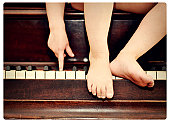
Home > Video Piano Lessons > Playing Chords With Your Left Hand
|
||||
Playing Chords With Your Left Hand
The simplest explanation for a chord is that it is the part of the music that keeps the melody and the beat. Playing piano chords with your left hand create the music harmony for the main melody over it. The piano consists of seven natural notes and five accidentals. The natural notes are the ivory keys and are named C-D-E-F-G-A and B. The ebony keys are the accidentals and change the tone of the ivory keys to either a sharp or a flat depending on how you look at it. For example, the accidental for F sharp is the exact same key as the accidental for G flat. This will come in useful when learning to read and play chords. Bass chords are thus named because of their location. Begin by looking at the piano keys and find the middle C key. This key should be the C key that is in the middle of the other C keys on the piano. Once you have found the middle C key you will be able to tell where to play your bass chords. Piano bass chords are always played below the middle C, or to the left side of the piano keys and with the left hand. The right hand plays the melody above the middle C and on the right side of the piano. Piano chords are usually deeper in sound and make up the musical background. They keep the rhythm and they help harmonize the song making it sound more complex. Piano chords are most often made of three notes, however, they can come in other numbers as well.
The bass chords you will play will depend upon your melody, or the notes your right hand is playing. A key point to keep in mind is that when ever you are playing a chord on your left hand, make sure that one of the notes in the chord match the note your right hand is playing simultaneously. This keeps the sound of the song harmonious. For example, if you play a G on your right hand, make sure the bass chord also has a G in it to make sense musically. It is also important to keep the rhythm of your left hand in time with the rhythm of your right hand. Many beginning piano players find it challenging to play right and left handed simultaneously. That is perfectly normal. However, it is better to stay at a slower pace and make your right hand match the rhythm of your bass chords when first learning to play. That will give you a sense of coordination later on. Some basic bass chord triads to practice with are the C major chord, which includes the C-E- and G notes, the D major triad which includes the D-F#- and A notes, the E major chords which include the E-G#-and B notes, and the A minor Chord which includes the A-C-and E notes. These are only a few beginner basic piano chords, but they are a great place to begin practicing.
=> http://pianoplayerworld.com/HarmonizeAnyTunes.html
| ||||
|
Although every attempt has been made to make information as accurate as possible, we are not responsible for any errors that may appear.
 If you are new to piano, you may be wondering what all of this talk about chords
is and may be curious about learning beginner piano bass chords.
If you are new to piano, you may be wondering what all of this talk about chords
is and may be curious about learning beginner piano bass chords.
 Chords with two notes are called dyads, chords with three notes are called triads,
chords with four notes are called tetrads and so on. For all purposes of beginning to learn chords, it is best
to begin with the three chord triads. These chords have a full sound and are not too difficult physically to
play.
Chords with two notes are called dyads, chords with three notes are called triads,
chords with four notes are called tetrads and so on. For all purposes of beginning to learn chords, it is best
to begin with the three chord triads. These chords have a full sound and are not too difficult physically to
play.



